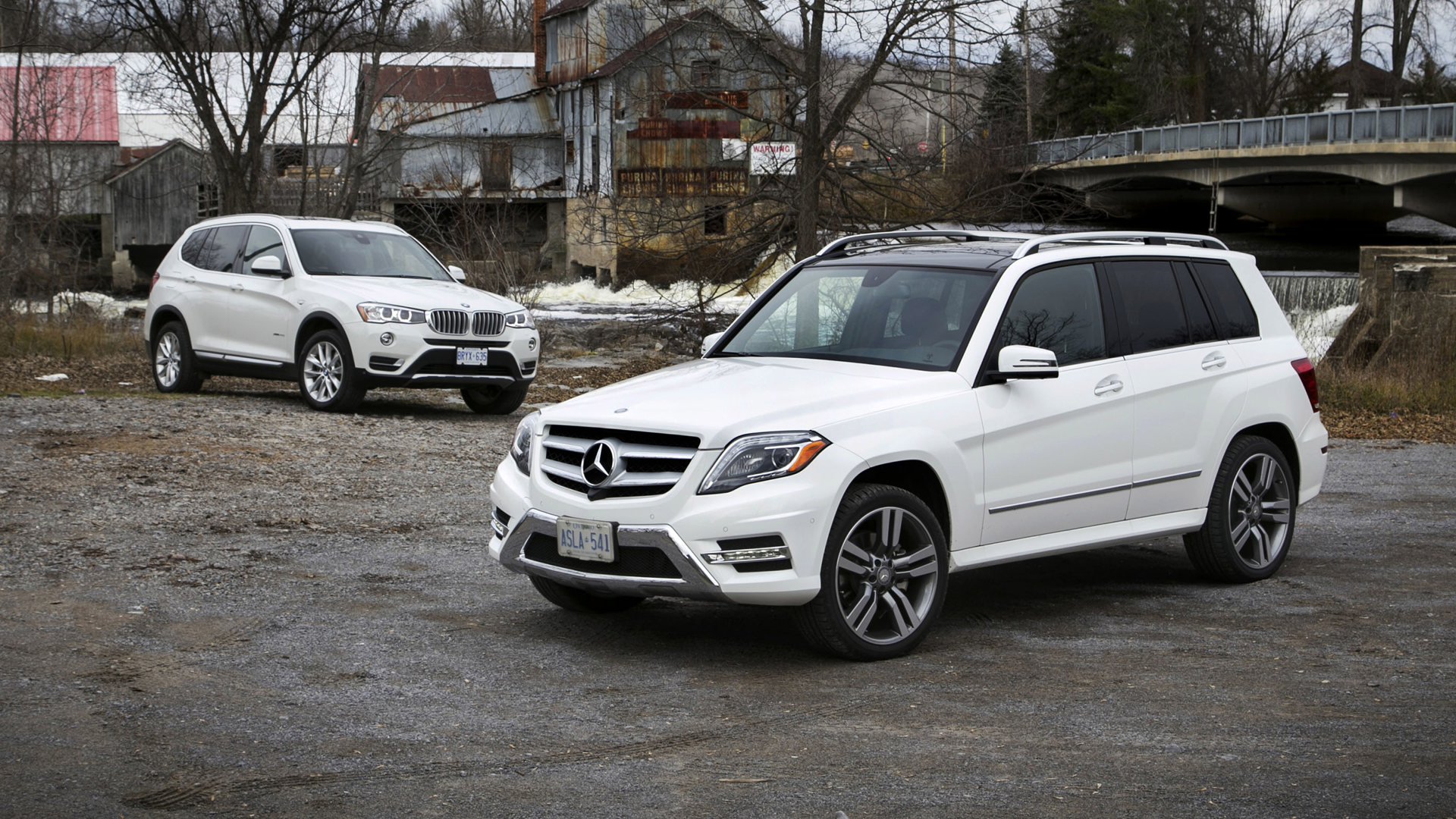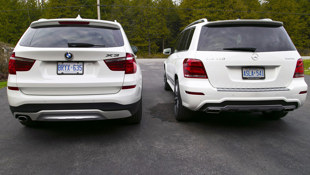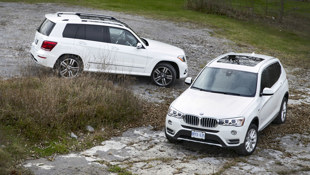Comparison Data
|
Base Price
$45,000
|
$48,600
|
|---|---|
|
A/C Tax
$100
|
$100
|
|
Destination Fee
$2,095
|
$1,895
|
|
Price as Tested
$55,945
|
$54,795
|
|
Optional Equipment
Premium Package Enhanced, $6,000 (key features include: Comfort Access, Rear View Camera, Automatic Trunk, Park Distance Control, Panorama Sunroof, Lights Package, On-Board Navigation, SIRIUS Satellite Radio, Harman Kardon Sound System); Technology Package, $1,600 (High-Beam Assistant, Active Blind Spot Detection, Lane Departure and Collision Warning); ConnectedDrive Services, $500; Manual Side Sunshades, $350; Storage Compartment, $300.
|
AMG Sport Package, $1,100 (AMG Styling Package, 20” 5- Twin-Spoke wheels); Avantgarde Plus Edition, $3,100 (key features include: Power Passenger’s Seat, Sirius Satellite Radio, Parking Package, Light & Sight Package, Heated Steering Wheel, Parktronic w/ Active Parking Assist, 360-degree camera, Keyless-Go)
|
It really doesn’t matter which vehicle wins this comparison test, for as cliché as it sounds, it’s the Canadian consumers shopping this segment who are winning. Both of these compact luxury utility vehicles are outstanding. Each is an overachiever in fuel efficiency, yet gives up little in the name of style, all-season practicality or comfort. In fact, we as North Americans should be getting down on our knees and thanking BMW and Mercedes for finally bringing really good – and reasonably priced – diesel offerings to our shores.
To put it another way, I really, really like these two little rigs, and I generally dislike sport utility vehicles with considerable intensity.
Last year I spent a week driving the then-new diesel offering in the compact Mercedes-Benz GLK 250 Bluetec and fell in love with it, calling it an absolute winner in the compact luxury crossover field.
So when word came that BMW wanted to join the party with a diesel version of their popular X3 compact “sport activity vehicle”, calls were placed and emails sent to set this comparison in motion.
Design
Hey, I get it, styling is a subjective thing, no debate here. But sometimes the look of a vehicle just puts it head and shoulders above the rest of the competition, standing out as a beauty amongst the beasts, like spotting Charlize Theron in an Oklahoma Walmart.
Between these two, there really isn’t a clear winner. Each one is handsome and wears the family face well, but they’re utility vehicles, not sleek coupes, and so “sexy” is not a descriptive one would toss around when discussing the GLK or X3.
Sometimes the look of a vehicle just puts it head and shoulders above the rest of the competition, standing out as a beauty amongst the beasts, like spotting Charlize Theron in an Oklahoma Walmart.
Both vehicles are in their second generation now and although BMW’s refresh happened two years earlier (2011 for North America), it was a much more thorough overhaul. Consequently the X3 with its strong X5 resemblance is the more contemporarily styled machine.
It takes a keen eye to spot the differences in appearance between a 2012 GLK and a 2013 model. The lights, front and rear, are the only immediate giveaway, with even the wheels fitted to my press car having been around for the previous generation.
And yet, despite wearing essentially the same duds it showed up to the party with in 2010, it’s still my preferred style of the two. It’s square-jawed and purposeful in a class that’s usually shaped after organic food things. It does not require one to squint too much to see the GL-Class or even G-Wagen lineage here, and of course, for those buying a premium product, the huge three-pointed star on the nose declares to all that you’re most certainly not driving some plebian brand car.
Inside, the Benz takes the lead and runs with it. Clearly the older design of the two, the GLK’s dashboard is dressed in high quality materials, highlighted by the broad swath of dark-stained, high gloss wood and distinct circular vents.
By comparison, the BMW lacks some of the luxury feel, though giving up nothing in actual quality of switchgear. It’s just that the Bimmer’s designers decided that rather than a luxurious and stylish accent, they’d simply present a wall of soft-touch, expensive looking plastic dashboard material with a small splash of cold, aluminum trim. The centre console is dominated by brushed aluminum, which is likely to give drivers and passengers a few tactile surprises if the car has been sitting in either the blazing sun or frigid winter weather. BMW’s pleather seats do a less convincing job of trickery than the Benz’s faux bovine Artico hides.
This GLK was my driving companion’s first time piloting a Mercedes and he claimed that it delivered on his expectation of what a Benz should be: solid and luxurious. The BMW, he suggested, could be rebadged as a modern day Korean brand and not surprise him. This is intended less as an insult to the BMW and more a credit to how far the Korean brands have come, but does speak to a lack of individuality or specialness the GLK possesses.
Driving
Once perched, the comfort levels and supportiveness of the seats in either rig is a wash. Neither feels overly supple or luxurious, nor did either leave us feeling stiff, sore or fatigued after a long stint behind the wheel.
The view out is better from the little Mercedes, with its boxy profile providing taller side and rear glass. But if you still need help parking, the top-view camera system fitted to the Benz makes positioning the little ute in even the tightest parking spaces a snap.
The rest of the Mercedes COMAND system falls well behind BMW’s vastly superior iDrive infotainment system. The new iDrive enables easy data input through its touch panel atop the rotary dial control without needing to take one’s eyes off the road. The larger display is higher on the dash and offers much better resolution, not to mention more contemporary graphics, giving the BMW a better score here.
Firing up the diesels, a difference in character once again appears. The Mercedes, with its 2.1L four-cylinder starts, idles and runs along with a distant putter. It’s rated at only 200 hp (3,800 rpm) but a lusty 369 lb-ft of torque from as low as 1,600 rpm. This gives the GLK 250 plenty of oomph to pull away from a stop and execute passing maneuvers safely on the open road. Never will it be mistaken for the GLK 350’s V6, but then, it doesn’t pretend to be.
Mated to the well-spaced 7G-Tronic Plus seven-speed automatic transmission, the GLK 250 always seems to be in the right gear to maximize power and efficiency. Paddle shifters are included, though I can’t imagine anyone actually using them.
From the moment the start button is pushed, the BMW’s 1,995 cc four-banger does just that, bangs. And clatters and generally sounds like a small Kubota engine instead of a high-end German car. Both inside and outside, the X3 is notably noisier than the GLK.
The BMW is also down on power, presenting 181 ponies at 4,000 rpm and only 280 lb-ft of torque from 1,750 rpm. As with the Benz, if you don’t get into an X3 28d expecting it to perform like a 35i (or even a 28i) gas engine, you should not be disappointed. The BMW gets around town just fine and has enough power to merge onto the highway without breaking a sweat. When signaling to pass, however, make sure you’ve left a little more space than you would in the GLK, since the power deficit is noticeable at speed.
The eight-speed automatic in the BMW optimizes the efficiency of the engine by always having the right ratio available, regardless of speed.
In terms of handling, the GLK exhibited a planted demeanour when we managed to find some lightly traveled back roads with a few curves. Steering feel, too, was surprisingly superior to the X3’s somewhat aloof personality through the wheel. Some of this – and its relative lack of grip on the back roads – is likely due to the Pirelli SottoZero snow tires fitted to our test X3, while the Benz still wore its sportier all-season rubber.
At highway speed, the BMW always seemed a little unsettled, requiring near-constant correction through the wheel. Once again, we’ll give BMW the benefit of the doubt and chalk this up to squishy new winter tire treads. The GLK always felt solid and planted.
Braking for both utes was smooth, linear and sufficient for the type of duty expected in this class of vehicle.
Utility
I’m a firm believer that SUVs need a healthy dose of utility to be worth their salt. Having a highly sensible diesel powertrain is a great start, and largely plays in to the practicality of the vehicle.
Mercedes rates its GLK 250 Bluetec at 9.6 L/100 km city and 7 L/100 km highway, while the BMW claims 8.6 city and 6.9 highway for their X3 28d. In reality, BMW’s estimates are pretty close to what one can expect from their little tractor, whereas the GLK’s ratings seem pessimistic.
With a 2/3 highway and 1/3 back road and urban split, we averaged 6.9 L / 100 km in the X3. On one highway stretch in strictly Eco Pro mode (that modifies the throttle calibration for maximum efficiency) I saw an average of 6.5 L/100 km for a 120 km distance.
The Benz, despite showing only 500 km on the odometer when we acquired it, cruised along sipping only 6.1 L/100 km of diesel. Throughout the entire trip, including hustling through the countryside and sitting in some Toronto traffic, the overall average for nearly 750 km was still in the low 6’s. These astonishing figures are in line with what I achieved last year in the GLK 250 Bluetec and suggest that consistently bettering the government ratings for this car should not be difficult.
Range for either ute will be similar and test even the most capacious of passenger bladders. The BMW’s fuel tank is 67 L, the Benz’s is 66.
But utility is about more than just punishing your passengers with long stints between bathroom breaks, it’s about how much space those passengers will have to squirm while cursing the car’s range. Subjectively, the back seat in both the X3 and GLK felt equally comfortable. The tall greenhouse that enables a commanding view for the driver also gives a more open and airy feel to the GLK’s passenger compartment, plus provides more rear headroom.
The BMW is the larger vehicle and on paper bests the Benz in most other dimensions, plus cargo capacity. In reality, the differences are often no more than a few centimetres here and there – hardly noticeable.
The Mercedes comes standard with proper roof racks versus the BMW’s sleeker-looking rails.
The spaciousness of the GLK’s interior is sufficient for a small family’s needs – or perhaps a pair of retirees who’ll rarely use the back seat for passengers anyway – but the comparatively worse fuel efficiency of the BMW will be felt with every fill up, earning the Benz the points for overall practicality.
| Dimension | X3 28d | GLK 250 |
|---|---|---|
| Overall length (mm) | 4,657 | 4,536 |
| Width (mm) | 1,881 | 1,840 |
| Height (mm) | 1,661 | 1,669 |
| Wheelbase (mm) | 2,810 | 2,755 |
| Cargo Capacity, seat up (L) | 550 | 450 |
| Cargo Capacity, seat down (L) | 1,600 | 1,550 |
| Front legroom (mm) | 1,013 | 1,057 |
| Rear legroom (mm) | 935 | 892 |
| Front headroom (mm) | 1,033 | 991 |
| Rear headroom (mm) | 994 | 1,008 |
Value
It is rare to secure two vehicles for a comparison test as equally matched as these. Dimensionally, mechanically and even the plain white paint almost make these two twins separated at birth and raised by different families. Pricing here is also about as close as they come with our GLK 250 tester tallying $52,800 and the X3 28d at $53,750. Scratch the ConnectedDrive package ($500) and a couple of inconsequential standalone options from the BMW and these two are nearly identically priced.
The BMW will appeal more to tech lovers with its excellent iDrive system, not to mention notably better Harman/Kardon Sound System (part of the Premium Package Enhanced at $6,000). The X3 also features functional items like High-Beam Assist, and Lane Departure and Collision Warning not found on the Mercedes.
The GLK has a solidity about it and more luxurious trim that make it feel like the more expensive vehicle. Plus, with the AMG Sport Package, it features fancier wheels and trim, for those who put style above gadgets.
Both are very well equipped and feature the niceties one expects of a $50,000+ machine, like panorama sunroof, parking sensors (and camera), power rear lift gate and keyless starting. Ultimately, BMW and Mercedes’ product planners did their homework in pricing these two extremely competitively. Neither is a better value than the other.
Conclusion
Between two vehicles as closely executed as the X3 28d and GLK 250 Bluetec, there is no clear and defined winner. With how great these powertrains are, choosing either one over any of the gasoline-powered siblings should be a no brainer. If you need more performance in a straight line, do you really need a utility vehicle?
Picking a favourite by eenie, meenie, miny, moe will still ensure a great choice is made and no matter which one you choose, you’ll earn a sincere thumb’s up from me. But, if I were putting my money down on one of these two, it would be the GLK 250 Bluetec that would be parked in my garage by virtue of its distinctive styling, refinement, solid road manners and better efficiency.

































